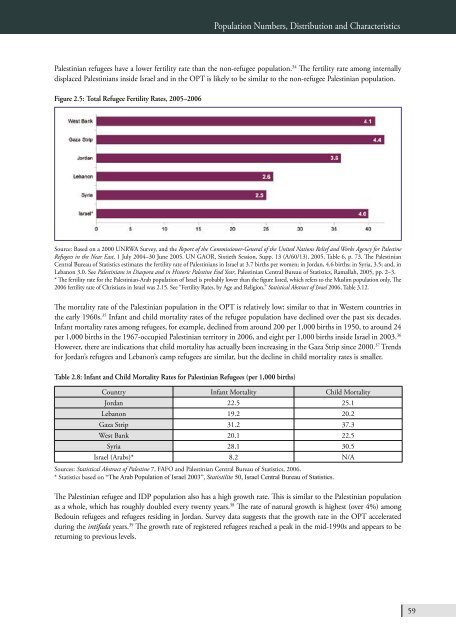BADIL Resource Center for Palestinian Residency and Refugee
BADIL Resource Center for Palestinian Residency and Refugee
BADIL Resource Center for Palestinian Residency and Refugee
Create successful ePaper yourself
Turn your PDF publications into a flip-book with our unique Google optimized e-Paper software.
Population Numbers, Distribution <strong>and</strong> Characteristics<br />
<strong>Palestinian</strong> refugees have a lower fertility rate than the non-refugee population. 34 The fertility rate among internally<br />
displaced <strong>Palestinian</strong>s inside Israel <strong>and</strong> in the OPT is likely to be similar to the non-refugee <strong>Palestinian</strong> population.<br />
Figure 2.5: Total <strong>Refugee</strong> Fertility Rates, 2005–2006<br />
Source: Based on a 2000 UNRWA Survey, <strong>and</strong> the Report of the Commissioner-General of the United Nations Relief <strong>and</strong> Works Agency <strong>for</strong> Palestine<br />
<strong>Refugee</strong>s in the Near East, 1 July 2004–30 June 2005. UN GAOR, Sixtieth Session, Supp. 13 (A/60/13), 2005, Table 6, p. 73. The <strong>Palestinian</strong><br />
Central Bureau of Statistics estimates the fertility rate of <strong>Palestinian</strong>s in Israel at 3.7 births per women; in Jordan, 4.6 births; in Syria, 3.5; <strong>and</strong>, in<br />
Lebanon 3.0. See <strong>Palestinian</strong>s in Diaspora <strong>and</strong> in Historic Palestine End Year, <strong>Palestinian</strong> Central Bureau of Statistics, Ramallah, 2005, pp. 2–3.<br />
* The fertility rate <strong>for</strong> the <strong>Palestinian</strong>-Arab population of Israel is probably lower than the figure listed, which refers to the Muslim population only. The<br />
2006 fertility rate of Christians in Israel was 2.15. See “Fertility Rates, by Age <strong>and</strong> Religion,” Statistical Abstract of Israel 2006, Table 3.12.<br />
The mortality rate of the <strong>Palestinian</strong> population in the OPT is relatively low; similar to that in Western countries in<br />
the early 1960s. 35 Infant <strong>and</strong> child mortality rates of the refugee population have declined over the past six decades.<br />
Infant mortality rates among refugees, <strong>for</strong> example, declined from around 200 per 1,000 births in 1950, to around 24<br />
per 1,000 births in the 1967-occupied <strong>Palestinian</strong> territory in 2006, <strong>and</strong> eight per 1,000 births inside Israel in 2003. 36<br />
However, there are indications that child mortality has actually been increasing in the Gaza Strip since 2000. 37 Trends<br />
<strong>for</strong> Jordan’s refugees <strong>and</strong> Lebanon’s camp refugees are similar, but the decline in child mortality rates is smaller.<br />
Table 2.8: Infant <strong>and</strong> Child Mortality Rates <strong>for</strong> <strong>Palestinian</strong> <strong>Refugee</strong>s (per 1,000 births)<br />
Country Infant Mortality Child Mortality<br />
Jordan 22.5 25.1<br />
Lebanon 19.2 20.2<br />
Gaza Strip 31.2 37.3<br />
West Bank 20.1 22.5<br />
Syria 28.1 30.5<br />
Israel (Arabs)* 8.2 N/A<br />
Sources: Statistical Abstract of Palestine 7, FAFO <strong>and</strong> <strong>Palestinian</strong> Central Bureau of Statistics, 2006.<br />
* Statistics based on “The Arab Population of Israel 2003”, Statistilite 50, Israel Central Bureau of Statistics.<br />
The <strong>Palestinian</strong> refugee <strong>and</strong> IDP population also has a high growth rate. This is similar to the <strong>Palestinian</strong> population<br />
as a whole, which has roughly doubled every twenty years. 38 The rate of natural growth is highest (over 4%) among<br />
Bedouin refugees <strong>and</strong> refugees residing in Jordan. Survey data suggests that the growth rate in the OPT accelerated<br />
during the intifada years. 39 The growth rate of registered refugees reached a peak in the mid-1990s <strong>and</strong> appears to be<br />
returning to previous levels.<br />
59

















